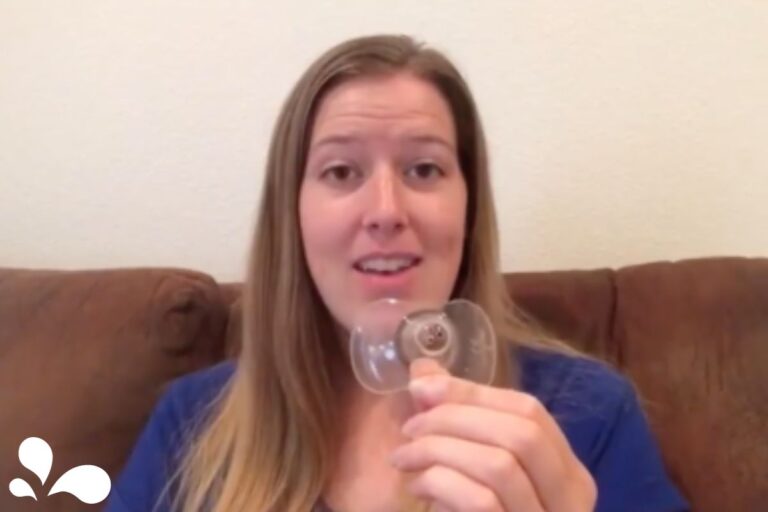Updated June 9, 2024
In this post, we’re going to walk you through the ins-and-outs of plugged milk ducts to help you know if you have a plugged milk duct, manage the pain of a plugged milk duct, and prevent future plugged ducts.
Your breast has ducts, or ‘pipes,’ that carry breastmilk from the alveoli, grape-like structures that produce and store breastmilk, to your nipples during breastfeeding. It is common to experience a plugged milk duct during breastfeeding, especially if your breastfeeding technique needs improvement (more on that later).
What are plugged milk ducts?
A plugged duct, more accurately referred to as ductal narrowing, occurs when milk builds up within your milk duct due to inflammation and narrowing of the ductal lumens. This narrowing can be caused by alveolar distension, mammary dysbiosis, or other inflammatory processes within the breast tissue. The build-up of milk creates a blockage, often called a “plug.”
What can cause plugged ducts?
Other causes of plugged ducts can be wearing a tight-fitting bra or other tight clothing, a sudden decrease in breastfeeding, and engorgement. The most common cause of a plugged milk duct is a poor feeding technique where you do not empty your breast during a breastfeeding session, the baby doesn’t latch properly, or the baby’s position to your breast isn’t optimal.
- Alveolar distension
- Mammary dysbiosis
- Other inflammatory processes within the breast tissue
- Wearing a tight-fitting bra
- Wearing other tight clothing
- A sudden decrease in breastfeeding
- Engorgement
- A poor feeding technique
- Improper latch
- Suboptimal breastfeeding position
It’s important to note that a “plug” is not a solid mass obstructing the duct but rather a result of ductal inflammation and narrowing.
A lactation consultant will help you master your breastfeeding technique to manage and prevent plugged milk ducts.
Guide: Positioning and Latch Checklist
Blog post: How to Fix a Shallow Latch & Get Baby to Latch Deeper

How to tell if you have a plugged duct while breastfeeding
You might have a plugged duct from breastfeeding if you feel a painful area or lump in your breast. You may also see a white spot or obstruction on your nipple, a milk bleb.
Most of the time, plugged milk ducts are not associated with a fever or other flu-like symptoms. If you have a fever, you may have mastitis. Read more about Mastitis.
How to manage plugged ducts while breastfeeding
Plugged milk ducts can be extremely painful, and you may want to slow or stop breastfeeding, but that is the last thing you should do. If you stop or slow breastfeeding, your breasts may become engorged, which will be more painful.
The best way to remove a plugged milk duct is to remove the blockage and thoroughly drain the breast. There are many ways to remove the blockage and drain your breast:
- Gentle Massage and Breast Gymnastics: Gently massage your breast, starting at the nipple and working your way toward the painful area (always massaging toward the nipple). This will help remove the blockage and drain your breast. Avoid deep massage as it can cause more inflammation and tissue injury. Implement breast gymnastics into your breastfeeding or pumping regimen to help reduce inflammation and get milk moving.
- Vary Breastfeeding Positions: Vary your positions during a breastfeeding session and try to position your baby’s chin near your breast’s most painful part. Doing these things will help remove the blockage and get breastmilk flowing again in that milk duct.
- Avoid Excessive Hand Expressing or Pumping: Avoid excessive pumping or hand expression as it can lead to hyperlactation and further inflammation.
- Pain Management: Consult your doctor about taking mild pain medication such as Tylenol or Ibuprofen to manage the pain if you have a plugged milk duct. Ice packs can also help reduce pain and inflammation.
- Avoid Heat: Using heat can worsen symptoms by causing vasodilation, which may increase swelling and pain. Stick to cold treatments to help reduce inflammation.
Update 8/1/22:
The Academy of Breastfeeding Medicine just updated its protocol for Mastitis. They no longer recommend using heat, vibrating devices, deep massage, or pumping to help manage mastitis.
Academy of Breastfeeding Medicine
A plugged duct usually only lasts about 48 hours. If you’re still experiencing pain after 48 hours, please contact your healthcare provider.

How to prevent plugged ducts
The best way to prevent a plugged milk duct is to first avoid any of the issues listed in “What can cause plugged ducts?” After you’ve done that, if you are still having difficulties, you might want to work with a lactation specialist who will help you with breastfeeding techniques.
In our Breastfeeding Basics Online Course, we cover different breastfeeding positions and latch techniques to help you avoid problems and breastfeed with confidence.
If you find that you get plugged milk ducts frequently, a supplement called Sunflower Lecithin can help. Sunflower Lecithin can help decrease the “stickiness” of the fat in your milk.
Start by taking 3600-4800 mg of Sunflower Lecithin daily, or 1 capsule 3-4 times a day. After 2 weeks of no plugged milk ducts, you can decrease the dosage by one capsule daily. Repeat this process until you are taking one capsule daily to prevent plugged milk ducts.
Originally posted September 9, 2020








